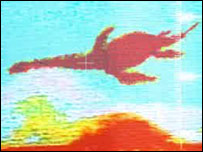New Hi Tech Search For Loch Ness Monster
Posted by: Craig Woolheater on April 23rd, 2007

A mock up of Nessie on a sonar screen
Tourist boat hopes to find Nessie
A cruise company is to fit sonar equipment to its flagship boat in case it passes over the Loch Ness Monster.
Jacobite – Experience Loch Ness has been demonstrating the search gear at VisitScotland Expo 2007 at the Royal Highland Centre in Edinburgh.
The company has had a fake video made of Nessie swimming across a sonar screen to illustrate how it would work.
The equipment will be fitted to the Jacobite Queen which takes tourists on cruises around the loch.
Freda Rapson, owner of Jacobite, said: “We’ve taken a genuine sonar scan and, with the help of technical experts, added what every visitor to the Loch hopes to see – Nessie.
“It’s been a while since the last sighting of the Loch Ness Monster. That could be about to change, though, now the Jacobite Queen’s got sonar aboard.”
‘Circus elephant’
Unexplained sightings of “something” in Loch Ness date back to the 6th Century.
Various theories have been offered to what the monster could be.
They include it being from a group of extinct marine reptiles called plesiosaurs, which used two sets of powerful flippers for swimming.
They came in two varieties – one with a small head and very long neck, and another with a large head and short neck.
In 2006, a scientist suggested the monster may have been an elephant.
Neil Clark, curator of palaeontology at Glasgow University’s Hunterian Museum, spent two years researching Nessie.
He said sightings could have been of circus elephants, as fairs visiting Inverness would often stop on the banks of Loch Ness to give the animals a rest.
The trunk and humps in the water would bear similarities to some of the most famous Nessie photographs.BBC News
The Loch Ness Monster as elephant theory has been discussed here on Cryptomundo several times.
See:
Nessie as Elephant Theory Shortsighted
Elephant or Lake Monster? What Do You Think?
Nessie: Pachyderm, Plesiosaur or Pinniped?
About Craig Woolheater
Co-founder of Cryptomundo in 2005.
I have appeared in or contributed to the following TV programs, documentaries and films:
OLN's Mysterious Encounters: "Caddo Critter", Southern Fried Bigfoot, Travel Channel's Weird Travels: "Bigfoot", History Channel's MonsterQuest: "Swamp Stalker", The Wild Man of the Navidad, Destination America's Monsters and Mysteries in America: Texas Terror - Lake Worth Monster, Animal Planet's Finding Bigfoot: Return to Boggy Creek and Beast of the Bayou.









Why not give the customer the fantasy they’re looking for… keeps em’ coming back.
Maybe the next thing will be heat detecting binoculars to view Bigfoot at night… because we all know BF only comes out at night. 😉
Whatever is the Loch, it’s not a monster. An elephant’s trunk is preposterous. A type of long necked seal, it would be seen more frequently. A large conger eel that breaks the surface while chasing prey is more likely.
Boy let’s hope the images are that good, the last time anyone tried sonar it was more of just a large blob. It was definitely something, but a nessie blob.
I just read the Steve Alten book, The Loch, and am very interested in the eel theory. It sounds like a few species of very large and often angry eels reside there and it seems feasible to me that these may be the culprit. Even if it is not a dinosaur type monster, I still think it is pretty incredible that predators over 10 ft. long may inhabit a fresh water habitat.
So, is there some NEW sonar technology out there so that we can actually get clear pictures out there in the peaty loch, or are they just wishful thinking?
I am not up on the latest tech stuff, but I didn’t think it yet possible to get those kind of distinct pictures…unless maybe only a few yards away, and then forget it…or at least GOOD LUCK.
In the 1904 survey report they devoted an entire chapter to mirages.
Nessie information has been good at times and horrible at other times. If nothing else there’s probably “something” in the Loch that nobody knows about, even if it just is large eels. Let us not forget the image of the “fin” taken years back, which would be hard to explain saying it was driftwood or something similar.